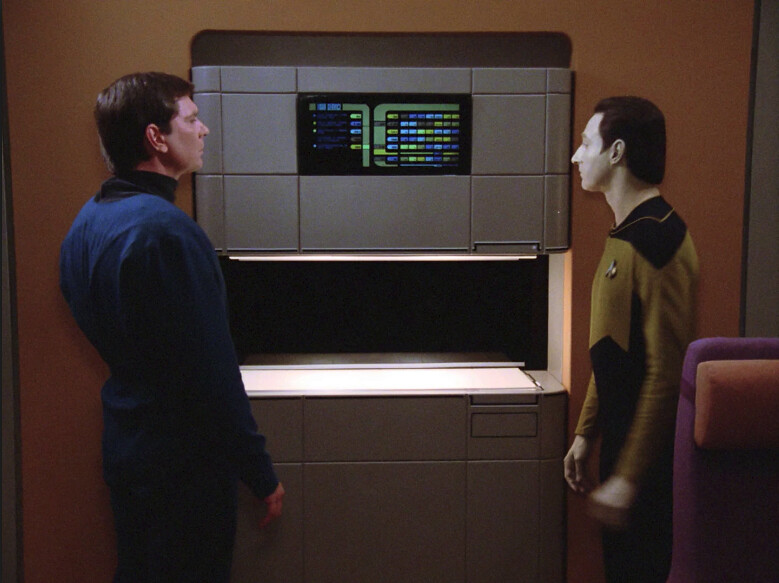Source: Memory-Alpha
The Star Trek franchise has generated millions of fans the inception decades ago. With those millions of fans, comes endless discussions about past, present, and future happenings of the franchise and the employees (producers, actors, writers, etc.). In the post below, a short video (less than 8 minutes in length) is shown to give the readers and sense of the state of technology in the past decade toward making an actual "Replicator". Enjoy!
As many of you may know, there is a large group of people who consider themselves "Trekkies" -- avid fans of the Star Trek enterprise. My wife - Kayla is a "Trekkie" which for those who are unaware of the term is described by the 'Wikipedia' page for "Trekkie" below:
The description seems rather ambiguous in some sense.A Trekkie or Trekker is a fan of the Star Trek franchise, or of specific television series or films within that franchise.
Are we there yet? How close is technology to the development of a Star Trek Replicator?
A few years ago -- back in 2014 -- Prof. Neil Gershenfeld described in a short video the state of technology and the 'parallel steps' needed to achieve this goal as shown below:
Wow. The fans of Star Trek might disagree on the actual timeline for completing a true "Replicator" Professor Neil Gershenfeld. Although, as highlighted in the video above, the necessary steps toward producing the technology to make a "Replicator" involve changing (slightly) the way manufacturing is done today. I would be interested in hearing Professor Neil Gershenfield's current thoughts on the timeline today in 2018. The video above was made in 2012.
Has the timeline improved or slowed down based on our current technological progress?
How about the momentum from the political side in changing the timeline?
What steps have the current Administration taken to support producing technology to make a "Replicator" in the near future?
The Star Trek Replicator has been compared to a '3D Printer' in today's technology as shown in the picture below - taken from the "Wikipedia" page:
Source: Shisma
With a description from the "Wikipedia" page for Star Trek Replicator shown below:
Although previous sci-fi writers had speculated about the development of "replicating" or "duplicating" technology,[1] the term "replicator" was not itself used until Star Trek: The Next Generation. In simple terms, it was described as a 24th century advancement from the 23rd century "food synthesizer" seen in Star Trek: The Original Series. In Star Trek the original series food was created in various colored cubes. In the animated series (1974), various types of realistic looking food could be requested as in the episode entitled "The Practical Joker". The mechanics of these devices were never clearly explained on that show. The subsequent prequel series, Star Trek: Enterprise, set in the 22nd century, featured a "protein resequencer" that could only "replicate certain foods," so an actual chef served on board who used "a hydroponic greenhouse" where fruits and vegetables were grown. Additionally, that ship had a "bio-matter resequencer" which was used to recycle waste product into usable material.[2]According to an academic thesis: "The so-called 'replicators' can reconstitute matter and produce everything that is needed out of pure energy, no matter whether food, medicaments, or spare parts are required."[3] A replicator can create any inanimate matter, as long as the desired molecular structure is on file, but it cannot create antimatter, dilithium, latinum, or a living organism of any kind; in the case of living organisms, non-canon works such as the Star Trek: the Next Generation Technical Manual state that, though the replicators use a form of transporter technology, it's at such a low resolution that creating living tissue is a physical impossibility.In its theory it seems to work similarly to a universal assembler.[citation needed]
In order to realize a true "Replicator" -- the necessary steps outlined by Professor Neil Gershenfeld will have to be taken. The timeline behind completing those steps are debatable and constantly changing. New code will have to be written to guide manufacturing. As a result, the benefits to society overall will be realized whether directly tied to the project of creating a "Replicator" or not. Just as many adventures (research funded projects) result in improvement to society overall, the effort toward realizing this will differ no less. Not to mention, our understanding (as a society) of the challenges and understanding will greatly improve in the process. Nonetheless, the future is super exciting....stay tuned.
Related Blog Posts:
Example Of Tesla's Self Driving Car Feature - Video - Amazing!
Parameters: 3D Printed Human Hearts?
Parameters: Can Computers Think?
Science Topics, Thoughts, and Parameters Regarding Science, Politics, And The Environment!


No comments:
Post a Comment